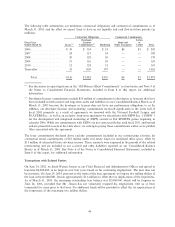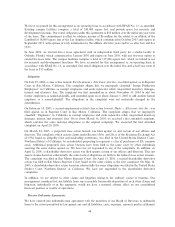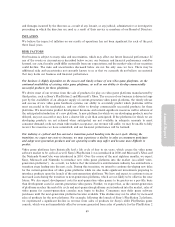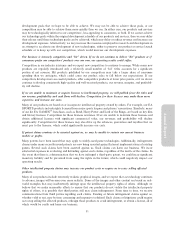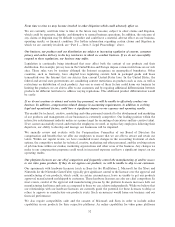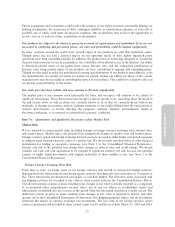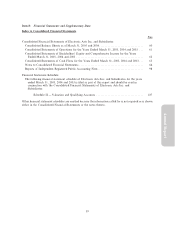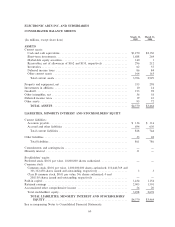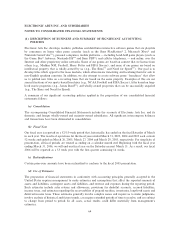Electronic Arts 2005 Annual Report Download - page 110
Download and view the complete annual report
Please find page 110 of the 2005 Electronic Arts annual report below. You can navigate through the pages in the report by either clicking on the pages listed below, or by using the keyword search tool below to find specific information within the annual report.Our reported Ñnancial results could be adversely aÅected by changes in Ñnancial accounting standards or
by the application of existing or future accounting standards to our business as it evolves.
As a result of the enactment of the Sarbanes-Oxley Act and the review of accounting policies by the SEC and
national and international accounting standards bodies, the frequency of accounting policy changes may
accelerate. For example, the FASB has issued a new standard that will require us to adopt a diÅerent method
of determining and accounting for the compensation expense of our employee stock options. This and other
possible changes to accounting standards, could adversely aÅect our reported results of operations although not
necessarily our cash Öows. Further, accounting policies aÅecting software revenue recognition have been the
subject of frequent interpretations, which could signiÑcantly aÅect the way we account for revenue related to
our products. As we enhance, expand and diversify our business and product oÅerings, the application of
existing or future Ñnancial accounting standards, particularly those relating to the way we account for revenue,
could have a signiÑcant adverse eÅect on our reported results although not necessarily on our cash Öows.
The majority of our sales are made to a relatively small number of key customers. If these customers
reduce their purchases of our products or become unable to pay for them, our business could be harmed.
In the U.S., in Ñscal 2005, over 80 percent of our U.S. sales were made to six key customers, two of which
have recently announced plans to merge. In Europe, our top ten customers accounted for over 30 percent of
our sales in that territory in Ñscal 2005. Worldwide, we had direct sales to one customer, Wal-Mart Stores,
Inc., which represented 14 percent of total net revenue in Ñscal 2005. Though our products are available to
consumers through a variety of retailers, the concentration of our sales in one, or a few, large customers could
lead to a short-term disruption in our sales if one or more of these customers signiÑcantly reduced their
purchases or ceased to carry our products, and could make us more vulnerable to collection risk if one or more
of these large customers became unable to pay for our products. Additionally, our receivables from these large
customers increase signiÑcantly in the December quarter as they stock up for the holiday selling season. Also,
having such a large portion of our total net revenue concentrated in a few customers reduces our negotiating
leverage with these customers.
Acquisitions, investments and other strategic transactions could result in operating diÇculties, dilution to
our investors and other negative consequences.
We have evaluated, and expect to continue to evaluate, a wide array of potential strategic transactions,
including (1) acquisitions of companies, businesses, intellectual properties, and other assets, and (2) invest-
ments in new interactive entertainment businesses (for example, online and mobile games). Any of these
strategic transactions could be material to our Ñnancial condition and results of operations. Although we
regularly search for opportunities to engage in strategic transactions, we may not be successful in identifying
suitable opportunities. We may not be able to consummate potential acquisitions or investments or an
acquisition or investment may not enhance our business or may decrease rather than increase our earnings. In
addition, the process of integrating an acquired company or business, or successfully exploiting acquired
intellectual property or other assets, could divert a signiÑcant amount of our management's time and focus and
may create unforeseen operating diÇculties and expenditures. Additional risks we face include:
‚ The need to implement or remediate controls, procedures and policies appropriate for a public company
in an acquired company that, prior to the acquisition, lacked these controls, procedures and policies,
‚ Cultural challenges associated with integrating employees from an acquired company or business into
our organization,
‚ Retaining key employees from the businesses we acquire,
‚ The need to integrate an acquired company's accounting, management information, human resource
and other administrative systems to permit eÅective management, and
‚ To the extent that we engage in strategic transactions outside of the United States, we face additional
risks, including risks related to integration of operations across diÅerent cultures and languages,
currency risks and the particular economic, political and regulatory risks associated with speciÑc
countries.
54




